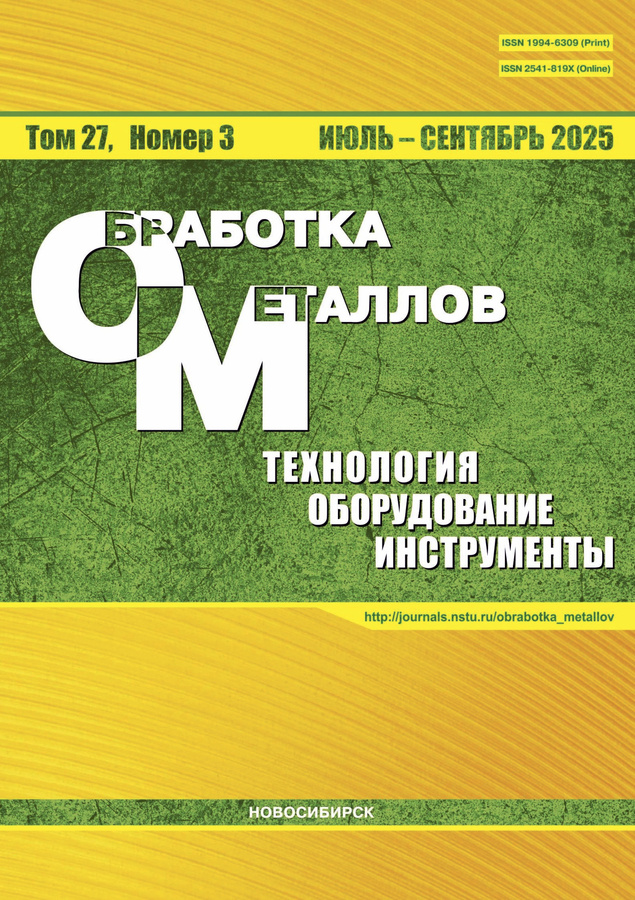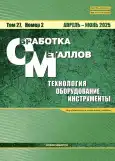Условия изготовления биметаллических образцов на основе железных и медных сплавов методом проволочного электронно-лучевого аддитивного производства
- Авторы: Осипович К.С.1, Сидоров Е.А.1, Чумаевский А.В.1, Никонов С.Ю.1, Колубаев Е.А.1
-
Учреждения:
- Выпуск: Том 27, № 2 (2025)
- Страницы: 142-158
- Раздел: ОБОРУДОВАНИЕ. ИНСТРУМЕНТЫ
- URL: https://ogarev-online.ru/1994-6309/article/view/301431
- DOI: https://doi.org/10.17212/1994-6309-2025-27.2-142-158
- ID: 301431
Цитировать
Аннотация
Об авторах
К. С. Осипович
Email: osipovich_k@ispms.ru
Институт физики прочности и материаловедения СО РАН, Академический проспект, 2/4, Томск, 634055, Россия, osipovich_k@ispms.ru
Е. А. Сидоров
Email: eas@ispms.ru
Институт физики прочности и материаловедения СО РАН, Академический проспект, 2/4, Томск, 634055, Россия, eas@ispms.ru
А. В. Чумаевский
Email: tch7av@gmail.com
доктор техн. наук, Институт физики прочности и материаловедения СО РАН, Академический проспект, 2/4, Томск, 634055, Россия, tch7av@gmail.com
С. Ю. Никонов
Email: SergRFF@ispms.ru
канд. физ.-мат. наук, Институт физики прочности и материаловедения СО РАН, Академический проспект, 2/4, Томск, 634055, Россия, SergRFF@ispms.ru
Е. А. Колубаев
Email: eak@ispms.tsc.ru
доктор техн. наук, Институт физики прочности и материаловедения СО РАН, Академический проспект, 2/4, Томск, 634055, Россия, eak@ispms.tsc.ru
Список литературы
- Multimaterial powder bed fusion techniques / M. Mehrpouya, D. Tuma, T. Vaneker, M. Afrasiabi, M. Bambach, I. Gibson // Rapid Prototyping Journal. – 2022. – Vol. 28 (11). – P. 1–19. – doi: 10.1108/RPJ-01-2022-0014.
- Zadpoor A.A. Additively manufactured metallic porous biomaterials // Journal of Materials Chemistry B. – 2019. – Vol. 7 (26). – P. 4088–4117. – doi: 10.1039/C9TB00420C.
- Influence of processing parameters on the characteristics of stainless steel/copper laser welding / S. Chen, J. Huang, J. Xia, X. Zhao, S. Lin // Journal of Materials Processing Technology. – 2015. – Vol. 222. – P. 43–51. – doi: 10.1016/j.jmatprotec.2015.03.003.
- Hybrid parts produced by deposition of 18Ni300 maraging steel via selective laser melting on forged and heat treated advanced high strength steel / L. Kucerová, I. Zetková, Š. Jenícek, K. Burdová // Additive Manufacturing. – 2020. – Vol. 32. – P. 101108. – doi: 10.1016/j.addma.2020.101108.
- First-principles residual resistivity using a locally self-consistent multiple scattering method / V. Raghuraman, M. Widom, M. Eisenbach, Y. Wang // Physical Review B. – 2024. – Vol. 109. – P. 104204. – doi: 10.1103/PhysRevB.109.104204.
- Wittenburg K. Specific instrumentation and diagnostics for high-intensity hadron beams // CERN Yellow Reports. – Geneva, 2013. – P. 251–308. – doi: 10.5170/CERN-2013-001.251.
- Laser additive manufacturing of metallic components: materials, processes and mechanisms / D. Gu, W. Meiners, K. Wissenbach, R. Poprawe // International Materials Reviews. – 2012. – Vol. 57 (3). – P. 133–164. – doi: 10.1179/1743280411Y.0000000014.
- Understanding thermal behavior in the LENS process / M.L. Griffith, M.E. Schlienger, L.D. Harwell, M.S. Oliver, M.D. Baldwin, M.T. Ensz, M. Essien, J. Brooks, C.V. Robino, J.E. Smugeresky, W.H. Hofmeister, M.J. Wert, D.V. Nelson // Materials & Design. – 1999. – Vol. 20 (2–3). – P. 107–113. – doi: 10.1016/S0261-3069(99)00016-3.
- Angehrn N., Pagonakis I.G. A novel electron gun design approach with an externally assembled anode // IEEE Transactions on Electron Devices. – 2023. – Vol. 70 (11). – P. 5934–5939. – doi: 10.1109/TED.2023.3317367.
- Electron beam powder bed fusion of γ-titanium aluminide: effect of processing parameters on part density, surface characteristics, and aluminum content / J. Moritz, M. Teschke, A. Marquardt, L. Stepien, E. López, F. Brückner, M. Macias Barrientos, F. Walther, C. Leyens // Metals. – 2021. – Vol. 11 (7). – P. 1093. – doi: 10.3390/met11071093.
- A design of experiment approach for development of electron beam powder bed fusion process parameters and improvement of Ti-6Al-4V as-built properties / D. Braun, Y.I. Ganor, S. Samuha, G.M. Guttmann, M. Chonin, N. Frage, S. Hayun, E. Tiferet // Journal of Manufacturing and Materials Processing. – 2022. – Vol. 6 (4). – P. 90. – doi: 10.3390/jmmp6040090.
- Compositionally graded metals: a new frontier of additive manufacturing / D.C. Hofmann, J. Kolodziejska, S. Roberts, R. Otis, R.P. Dillon, J.-O. Suh, Z.-K. Liu, J.-P. Borgonia // Journal of Materials Research. – 2014. – Vol. 29. – P. 1899–1910. – doi: 10.1557/jmr.2014.208.
- Micro-, meso- and macrostructural design of bulk metallic and polymetallic materials by wire-feed electron-beam additive manufacturing / E.A. Kolubaev, V.E. Rubtsov, A.V. Chumaevsky, E.G. Astafurova // Physical Mesomechanics. – 2022. – Vol. 25. – P. 479–491. – doi: 10.1134/S1029959922060017.
- Alloys-by-design: application to new superalloys for additive manufacturing / Y.T. Tang, C. Panwisawas, J.N. Ghoussoub, Y. Gong, J. Clark, A. Németh, D.G. McCartney, R.C. Reed // Acta Materialia. – 2020. – Vol. 202. – P. 417–436. – doi: 10.1016/j.actamat.2020.09.023.
- Phase formation, microstructure, and mechanical properties of Ni-Cu bimetallic materials produced by electron beam additive manufacturing / K. Osipovich, D. Gurianov, A. Vorontsov, E. Knyazhev, A. Panfilov, A. Chumaevskii, N. Savchenko, S. Nikonov, V. Rubtsov, E. Kolubaev // Metals. – 2022. – Vol. 12. – P. 1931. – doi: 10.3390/met12111931.
- Interfacial characteristic and mechanical performance of maraging steel-copper functional bimetal produced by selective laser melting based hybrid manufacture / C. Tan, K. Zhou, W. Ma, L. Min // Materials & Design. – 2018. – Vol. 155. – P. 77–85. – doi: 10.1016/j.matdes.2018.05.064.
- Additive manufacturing of metallic components – Process, structure and properties / T. DebRoy, H.L. Wei, J.S. Zuback, T. Mukherjee, J.W. Elmer, J.O. Milewski, A.M. Beese, A. Wilson-Heid, A. De, W. Zhang // Progress in Materials Science. – 2018. – Vol. 92. – P. 112–224. – doi: 10.1016/j.pmatsci.2017.10.001.
- Effect of heat input on phase content, crystalline lattice parameter, and residual strain in wire-feed electron beam additive manufactured 304 stainless steel / S.Y. Tarasov, A.V. Filippov, N.L. Savchenko, S.V. Fortuna, V.E. Rubtsov, E.A. Kolubaev, S.G. Psakhie // The International Journal of Advanced Manufacturing Technology. – 2018. – Vol. 99. – P. 2353–2363. – doi: 10.1007/s00170-018-2643-0.
- Study on powder particle behavior in powder spreading with discrete element method and its critical implications for binder jetting additive manufacturing processes / S. Wu, Y. Yang, Y. Huang, C. Han, J. Chen, Y. Xiao, Y. Li, D. Wang // Virtual and Physical Prototyping. – 2023. – Vol. 18 (1). – P. 1–26. – doi: 10.1080/17452759.2022.2158877.
- Materials for additive manufacturing / D. Bourell, J.P. Kruth, M. Leu, G. Levy, D. Rosen, A.M. Beese, A. Clare // CIRP Annals Manufacturing Technology. – 2017. – Vol. 66. – P. 659–681. – doi: 10.1016/j.cirp.2017.05.009.
Дополнительные файлы







